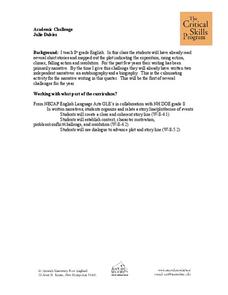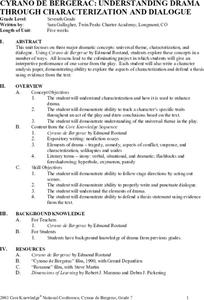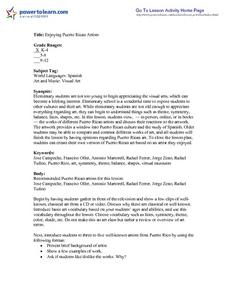Curated OER
Malambo
Students use appropriate terms to reflect a working knowledge of the musical elements and use terminology from music and dance to analyze and compare structures of musical and other artistic works. They also identify the purpose of the...
Curated OER
Storytelling
Students compose a story and tell it to the class. In this storytelling lesson, students work in small groups to create an illustrated story. Students are given a checklist of elements to include in the assignment. Students then create...
Curated OER
In A Station Of The Metro And A Pact
Young scholars are exposed to two different works of poetry in order to complete a task of comparing and contrasting them. They analyze the poem and identify the juxtaposition. The analysis is compiled by them to make a class report of it.
Curated OER
Fairy Tales, Past and Present
Young scholars examine the different elements of a fairy tale. They discover why setting, characters, problems and solutions are important in a fairy tale. They recreate the fairy tale in modern times and create a storybook to accompany...
Curated OER
The Book Project
In this book project worksheet, students select a container to decorate and fill with questions, vocabulary, and other items that depict the elements of the text in some way.
Curated OER
Evaluating Conclusions
Tenth graders evaluate seven conclusions which use A Doll's House for the prompt response. They develop criteria for writing effective conclusions which respond to an End-of-Course II writing prompt.
Curated OER
Exploring Pottery of North Carolina
Eighth graders explore the pottery traditions of North Carolina through a progression of investigation and hands on experience. State Standards are addressed during this two to three week lesson on regional pottery techniques.
Curated OER
Reader R.E.A.C.T.I.O.N.
Students practice their reading comprehension skills. In this reading skills lesson, students use the R.E.A.C.T.I.O.N. model to identify story elements in books that students elect to read independently.
Curated OER
Cyrano De Bergerac: Understanding Drama Through Characterization and Dialogue
Students explore three major dramatic concepts using Cyrano de Bergerac by Edmond Rostand. In this dramatic concepts lesson, students research the concepts of universal theme, characterization, and dialogue using the given text. Students...
Curated OER
In Depth: Pearblossom Highway
Students analyze a photograph and a photo-collage showing the same highway. In this visual arts lesson, students write a descriptive paragraph about both images and identify one-point perspective in art. Students then draw a desert...
Curated OER
Jacob the Great
For this reading comprehension worksheet, students read a 1 page passage titled Jacob the Great and complete comprehension, inferential, and story element questions about it. Students complete 22 multiple choice questions.
Curated OER
Enjoying Puerto Rican Artistts
Students examine artwork done by artists from Puerto Rico. As a class, they discuss each piece of work based on the elements used. They use the internet to research the lives of the artists and develop their own opinions on the art...
Curated OER
Blueprint Writing
Eighth graders write a narrative composition about funny incidents in their home lives. In this narrative writing lesson, 8th graders define what a blueprint is and draw one for their home. Students write about events that happened in...
Curated OER
New Forms from Old
Students look at historic porcelain objects. In this visual arts activity, students examine how the use of historic objects has changed over time. Students design their own object from paper cups, bowls, plates, and more.
Curated OER
Praise for a Color
Students discover the 5 senses by analyzing poetry. In this poetry lesson, students read a poem with their class and analyze how each sense plays into their understanding of the poem. Students write a poem based on a specific color...
Curated OER
The Real Me!
Fourth graders examine and explain who they are and communicate that person to the viewer through the use of the visual arts. They think about themselves and try to find five things that represent who they are and what they feel is...
Curated OER
And Then What Happened?
Students analyze paintings by using verbs, adjectives, and nouns. In this visual arts lesson, students view a painting of a storm and a calm sky. Students use various verbs and adjectives to discuss the characteristics of each painting....
Curated OER
Story Writing
Students work in groups to create a story that will be presented to the class. In this story writing lesson, students complete a project planning sheet, work together to create a story that includes a hero and at least two other...
Curated OER
Performing With Prepositions
Fifth graders write sentences that contain prepositional phrases in them. In this writing lesson, 5th graders trace prepositions in glue and glitter them in the sentences. A fun element of this lesson happens after the glitter has been...
Curated OER
The Japanese Empire: The Beginning
Ninth graders explore empires by researching Japan's history. For this Japanese research lesson, 9th graders discuss the history of Japan and the elements of World War II that caused Japan to become an enemy of the United States....
Curated OER
Understanding Irony
Students discuss irony. In this language arts lesson, students identify irony and give examples of irony from their lives, a book, and current events. Students classify types of irony.
Curated OER
Tell Me About It: What is Design? Creating a Design Workshop Part 2
Students create a workshop on basic design to introduce the concept to elementary students. In this design workshop lesson, students view two videos that provide basic design concepts. After discussing the concepts as a class, students...
Curated OER
Wyclef Jean for VH1 Storytellers
Students use different folk songs to learn chords and other musical elements.
Curated OER
This Isn't Your Little Sister's Poetry: Analyzing and Understanding a Variety of Acclaimed Poets
Eleventh graders are introduced to various basic and advanced poetic devices. They read several poems and practice identifying poetic elements. They identify at least two different poems and substantiate why they belong in the canon.

























